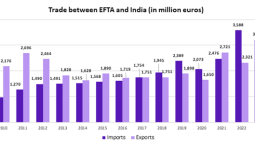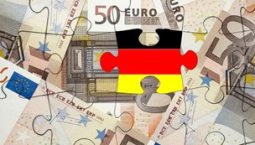Situated in the heart of Europe, Germany is the fourth-largest country in the European Union. It has assumed its status as a technology giant and one of the strongest economic powers in this world. The country has recorded unmatched socio-economic development despite the devastating scars of World War II.
Germany In Focus
Germany is known as one of the most industrialized countries in Europe and a trailblazer in space exploration, which itself suggests that all these endeavours boil down to using science for solving societal problems.It has one of the highest standards of living in the world. According to the 2021 United Nations Human Development Index, Germany ranked 9th out of 191 countries.
Germany occupies a land area of about 357,022 square kilometers (137,847 sq mi), presence that spans from the grand heights of the Alps to picturesque beaches on both North and Baltic Seas. Germany is a remarkably shaped seventh-largest country in the world with its mountainous terrains and maritime boundaries. Germany is bordered by neighboring countries with land borders spanning 3,621 kilometers.
Introduction
Positioned in the northern hemisphere, Germany spans latitudes 47° 17′ and 55° 5′ north and longitudes 5° 52′ and 15° 2′ east. The country’s mainland, including territories like the North Sea and the Baltic Sea, extends approximately 876 kilometers from north to south and about 640 kilometers from east to west. The mainland shares a substantial coastline, complemented by additional coastlines of the North Sea islands, the Baltic Sea islands, and territories such as Heligoland.
Germany’s geographical diversity, from the Alpine regions in the south to the coastal areas in the north, contributes to its unique identity and plays a vital role in its cultural, economic, and environmental tapestry

Geography
Location: To the north, Germany has access to the Baltic and the North Sea. Its southern border is in the Alps. Covering 357,588 square kilometres. The Rhine is the longest river. In the south-west of the country, it forms the border between Germany and France. Further to the north, Bonn, Cologne and Düsseldorf stand on its banks. Germany’s second-longest river, the Elbe, connects Dresden, Magdeburg and Hamburg before flowing into the North Sea.

Transportation
- Airports: Germany has a well-developed airport infrastructure managed by various authorities. Some of the major international airports include Frankfurt Airport, Munich Airport, Berlin Brandenburg Airport, Düsseldorf Airport, Hamburg Airport, and Cologne Bonn Airport.
- Railways: Germany has an extensive and efficient railway network operated by Deutsche Bahn. The country’s railway system covers around 41,000 kilometers, and high-speed trains like the Intercity-Express (ICE) connect major cities. Germany has a robust passenger and freight rail transportation system.
- Roadways: Germany is known for its high-quality road network, including the famous autobahns. The roadways span a vast network, facilitating the movement of both passengers and freight. The road system plays a significant role in the country’s transportation infrastructure.
- Waterways: Germany has an extensive network of inland waterways, including rivers and canals, totaling over 7,500 kilometers. The Rhine, Main, and Danube rivers are crucial for transporting goods, and Germany has a well-developed system of locks and canals.
- Ports: Germany has several major seaports that contribute to its maritime transportation. Some of the key ports include Hamburg, Bremerhaven, Rotterdam, Bremen, Wilhelmshaven, and Kiel. These ports play a crucial role in facilitating international trade and cargo shipments.
Overall, Germany’s transportation infrastructure is well-integrated, incorporating air, rail, road, and water transport to support efficient domestic and international connectivity.
Economic Profile
Germany anticipates a modest economic recovery following a challenging year marked by declining purchasing power, high inflation, and tightened financing conditions. Although a contraction of 0.3% is expected in 2023, a turnaround is projected with GDP growth reaching 0.8% in 2024 and 1.2% in 2025. The forecast outlines key economic indicators and factors influencing Germany’s economic trajectory.
Key Indicators (in percentages):
| Indicator | 2023 | 2024 | 2025 |
| GDP Growth (YoY) | -0.3 | 0.8 | 1.2 |
| Inflation (YoY) | 6.2 | 3.1 | 2.2 |
| Unemployment | 3.1 | 3.2 | 3.2 |
| Govt. Balance (% of GDP) | -2.2 | -1.6 | -1.3 |
| Gross Public Debt (% of GDP) | 64.8 | 63.6 | 62.7 |
| Current Account Balance (% of GDP) | 6.0 | 6.5 | 6.5 |
2023 Challenges
Economic activity declined by 0.1% in Q3 2023 due to weakened industrial production and reduced export volumes.
High inflation led to a loss of purchasing power, impacting private consumption.
Recovery Expectations
Real GDP is projected to contract by 0.3% in 2023 but rebound to 0.8% and 1.2% in 2024 and 2025, respectively.
Construction is set to grow, supported by high housing demand.
Despite elevated energy costs, a gradual recovery is expected, with net trade contributing positively.

Value of Exports & Imports
After calendar and seasonal adjustment, Germany exported goods to the total value of 131.2 billion euros and imported goods to the value of 110.8 billion euros in November 2023. Thus the foreign trade balance showed a surplus of 20.4 billion euros in November 2023, the highest in two years, driven by a 3.7% increase in exports and a modest 1.9% rise in imports compared to October.
However, year-on-year, exports were down 5%, while imports experienced a sharper decline of 12.2%. The overall surplus rose significantly from 11.9 billion euros to 20.4 billion euros, primarily influenced by a notable reduction in imports, attributed to declining global prices for oil, gas, and coal compared to the same period in 2022.

Employment in Germany at record level
In 2023, despite an economic slowdown, Germany achieved a record high in employment with an average of 45.9 million people, surpassing the previous peak in 2022 by 0.7% (330,000 people). This increase is attributed to both immigration and higher domestic workforce participation. However, it is anticipated that this peak will likely be reached this year or the next, leading to a subsequent decline in employment.
Slight increase in the unemployment rate
The unemployment rate experienced a slight uptick, reaching 5.7% in 2023. In December 2023, the number of unemployed individuals rose by 31,000 compared to November, and by approximately 183,000 compared to the same period in the previous year. Despite economic challenges, the labor market remained resilient, showcasing higher employment levels than ever before, and the unemployment rate in 2023 is among the lowest since German reunification in 1990.
Industrial Production
Industrial production measures the output of businesses integrated in industrial sector of the economy.
Manufacturing is the most important sector and accounts for 79 percent of total production. The biggest segments within Manufacturing are:
- Machinery and equipment (12 percent of total production)
- Motor vehicles, trailers and semi-trailers (12 percent)
- Basic metals and fabricated metal products (10 percent)
- Computers, electronic and optical products and electrical equipment (10 percent)
Construction accounts for 11 percent of total output; and Energy production accounts for 10 percent.
Industrial Production in Germany decreased 4.80 percent in November of 2023 over the same month in the previous year.













